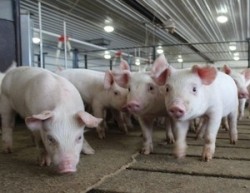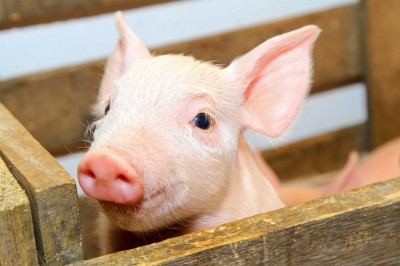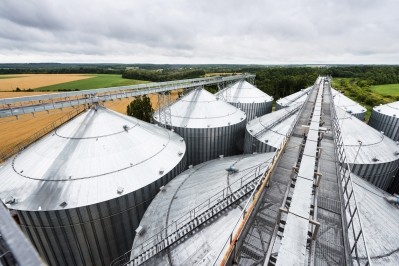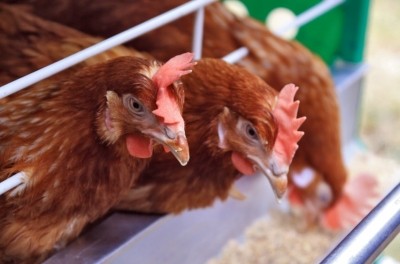special edition: pig and poultry feed trends
Wheat-DDGs drop feed efficiency in young swine diets, don’t alter intake

Researchers with the University of Alberta in Canada and Alberta Agriculture and Forestry examined the use of wheat-based dried distillers grains with solubles (DDGS) in the diets of young pigs, several weeks past weaning. The group published their results in the journal Animal Feed Science and Technology.
The study hypothesis was that older weaned pigs, when offered a diet where wheat-based DDGS replaced soybean meal would have similar growth performance and nutrient and gross energy (GE) digestibility to pigs getting a soybean meal diet, said the researchers.
“We basically [tried] to determine if pigs fed wheat DDGS in phase-3 diets could sustain growth performance compared to pigs fed soybean meal,” said corresponding researcher Ruurd Zijlstra, professor in the department of agricultural, food and nutritional science at the University of Alberta. “The main reason practically would be to reduce feed cost per unit of body weight gain.”
The feed ingredient could be substantially less expensive than soybean meal, depending on the commodity market, he said. “We wanted to evaluate slightly older pigs compared to our first study, because in our first study growth performance was drastically reduced at high inclusion of wheat DDGS,” he added.
The work is part of an ongoing review of feed ingredients, he told FeedNavigator. “We have conducted about 20 such trials with associated publications – and are gradually working our way through a full list, including with associated treatments such as processing, etc,” he added.
For more on his research efforts see our past write-ups of his work.
The group found that increasing the replacement of soybean meal (SBM) with DDGS tended to reduce average daily gain (ADG), but did not alter how much pigs consumed, said the researchers in the paper. “Weaned pigs fed diets with increasing inclusion of up to 200 g wheat DDGS/kg and supplemental AA to replace SBM had reduced G:F due to reduced ADG, but maintained feed intake,” they added.
Why wheat DDGs?
In areas including Canada, Australia and Europe wheat can be used in the production of ethanol and create by-product wheat distillers dried grains and solubles (DDGS), said the researchers. When compared to wheat grain, the by-product has 10-20% more GE, more protein, fiber and less starch.
Wheat DDGS may offer a cheaper, alternative feed ingredient for pigs, they said. However, in previous studies, use of the by-product to replace SMB limited growth performance and diet intake of weaned pigs, but did not alter growth of growing-finishing pigs.
But past studies used younger pigs than the current trial, said researchers in the study. “Evaluating inclusion of up to 200 g wheat DDGS/kg in diets fed to older weaned pig is warranted, because literature regarding dose response of weaned pigs to increasing wheat DDGS inclusion is scarce,” they added.
Study details
In the feeding trial, 160 pigs were given one of five pelleted diets for a period of three weeks, said the researchers. The wheat-based diets included 0, 50, 100, 150 or 200g wheat DDGS/kg replacing an equal amount of soybean meal.
Diets were designed to offer 9.8MJ net energy/kg and 1.16g standardized ileal digestible (SID) lysine/MJ NE, they said. Canola oil and crystalline amino acids were used to balance the feeds, but growth promoters were not used.
Pigs, feed added and remaining were weighed every seven days to determine average daily feed intake (ADFI), average daily gain (ADG) and feed efficiency (G:F), they said. Fecal samples and feed were analyzed for dry matter (DM), acid-insoluble ash and GE.
Results
Increasing amounts of wheat-based DDGS reduced apparent total tract digestibility coefficient (CATTD) of DM, GE and crude protein (CP) in a linear fashion, said the researchers. It also decreased diet digestible energy (DE) and limited then improved calculated NE value in a quadratic manner.
“In this study, feed intake at 20% inclusion of wheat DDGS was not reduced, and growth was slightly reduced,” said Zijlstra. “So likely digestibility amino acid or net energy might not been fully correct for diet formulation.
“For example, adding extra synthetic amino acids may overcome the problem of reduced growth,” he said. “Furthermore, processing of the diet or ingredient may enhance its nutrient digestibility.”
Increasing amounts of the DDGS in pig feed did not alter average daily feed intake (ADFI), said researchers. But, it did linearly decrease ADG for days one through seven, although not for the remainder of the trial.
Throughout the trial adding additional DDGS tended to lower G:F for days 1-7 and 15-21, they said. Final body weight for control group pigs was 27.8kg and for those getting 200g/kg wheat DDGS it was 26.9kg.
Source: Animal Feed Science and Technology
Title: Diet nutrient digestibility and growth performance of weaned pigs fed wheat dried distillers grains with solubles (DDGS)
DOI: dx.doi.org/10.1016/j.anifeedsci.2016.05.005
Authors: L. Wang, E. Beltranena, R. Zijlstra








